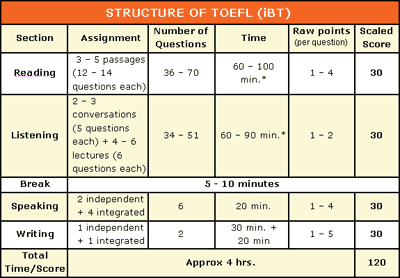Part I: TOEFL Registration and Overview
The TOEFL (Test of English as a Foreign Language) is a highly regarded exam that determines proficiency in the English language. The exam gauges university aspirants in their ability to use English in both academic and business environment; it is used world-wide in university and college admissions departments.
Yesterday's TOEFL article presented a general overview along with tips for exam registration. Today, we discuss in-depth the exam's structure and how test takers are evaluated.
The Internet Based TOEFL exam has four separate tests -- reading, listening, speaking and writing. The following diagram displays the exam structure:

Structure of Reading Test
Three to five academic reading passages followed by comprehension questions that measure the ability to understand and analyse the meaning of the passages.
Similar question types from the computer-based TOEFL test.
New question types:
~ Demonstrate they have learned what they have read, either by filling out a table or completing a narrative summary.
~ Choose a correct paraphrase of a reading.
New features that make the testing experience easier for test takers, including a glossary and review feature.
Structure of Listening Test
Two to three conversations that include two or more speakers in each.
Four to six lectures, which include classroom dialogue.
Opportunity to take notes while listening.
Smilar question types from the computer-based TOEFL test.
New question types that measure test takers' ability to understand a speaker's attitude or meaning.
Structure of Speaking Test
Total of six tasks to be completed by the test taker.
Two independent tasks about familiar topics.
~ Test takers state, explain and support their response using personal knowledge and experience.
Two tasks based on Reading and Listening material.
~ Tasks include a short reading passage and a short talk.
~ Questions require test takers to combine information from both the reading and the listening material.
~ One task is based on a campus-related situation, and the other is based on academic classroom material.
~ Test takers can take notes and use them to respond.
Two tasks based on Listening material, including a short lecture or conversation.
~ Questions require test takers to summarise key ideas from the talks in the responses.
~ One task is based on a campus-related situation, and the other is based on academic classroom material.
~ Test takers can take notes and use them to respond.
Trained evaluators gauge test takers' ability in:
~ Topic development -- show they understand and can make connections, and convey relevant information.
~ Delivery -- use clear, smooth, sustained speech for overall intelligibility.
~ Language use -- control of grammar and word choice, and respond coherently.
Structure of Writing Test
Total of two tasks to be completed by the test taker.
One Reading/Listening/Writing task -- an academic reading followed by a lecture
~ Test takers must answer a question discussing the key points in the lecture and explain how they relate to those in the reading passage.
~ Reading passage appears first, then is removed from the screen during the lecture. Test takers can view the passage again while responding to the question.
One independent task about a familiar topic
~ Test takers state, explain and support their response using personal knowledge and experience.
Trained evaluators gauge test takers' ability to demonstrate an understanding of the material, as well as write clearly, accurately and in a well-organised manner.
The integrated skills approach to assessment reflects real English use in everyday university situations -- both in and out of the classroom.
TOEFL score scales
Each of the four sections of TOEFL iBT is scored on a scale of 0 to 30. The sectional scores are then added to arrive at a total score of 0 to 120. Each score will also correspond to a percentile ranking, which shows how an individual score compares with the score of other students who have taken the same test.
The maximum score of 120 will have a percentile of 100, a score of 100 may have a percentile of, say, 89, a score of 75 a percentile of 59 and so on. In addition to the sectional scores, the total score and the percentile, students will also receive score descriptors of what the numeric scores mean in terms of language skills and proficiency (high/medium/low), along with performance feedback including suggestions for improvement.
Score scales are similar for the Reading section and the Listening section. The score values from 0-30 do not represent the number of questions a student answered correctly. If a student gets 35 questions right out of a total of 40 questions, he/ she will get a raw score of 35, which will then be scaled to give a range of 25-27. This scale estimate provides a general guide only, the actual score varying a little within this range.
The six tasks in the Speaking section are rated by at least two human scorers on a scale of 0-4. The six individual scores are averaged to arrive at an aggregate value. This aggregate is then converted to the scale of 0 to 30.
Likewise in the Writing section the two tasks are scored by at least two human scorers independently from 0 to 5 and then the raw scores are totaled/averaged before scaling them to the range of 0 to 30.
Part I: TOEFL Registration and Overview
-- KB Sharma is working with Top Careers & You as a Senior Verbal Trainer and is responsible for development and upgradation of Verbal content for GRE / GMAT / SAT / CAT preparation.
-- Nidhi Mahajan has been handling the English Language Proficiency training programmes in Top Careers & You for the last 5 years.





